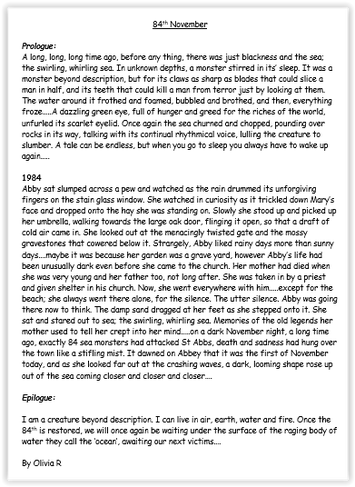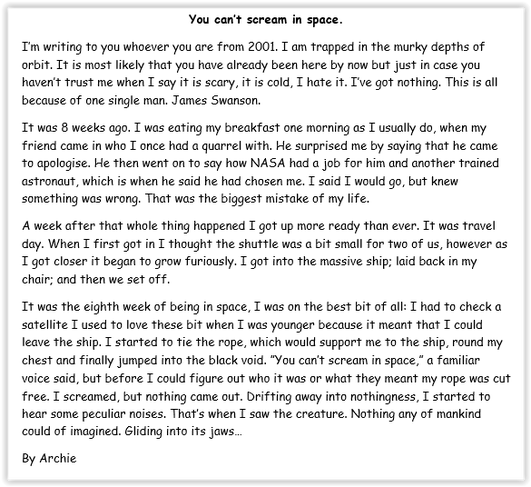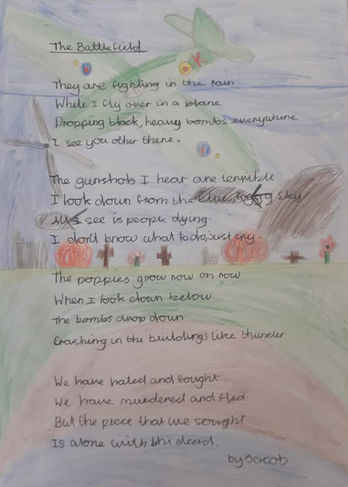- Home
- Our Academy
- Parents
- The School Day
- Foundation Stage - Reception
- Well-being
- Breakfast Club
- After School Clubs
- Home Learning
- Safeguarding Information and Guidance
- Online Safety
- School Holiday Pattern
- Attendance
- School Uniform
- Parents/School Meals & Packed Lunches
- Late/Absence Procedures
- Willow Graduate Programme - Independent Study Resources for Pupils
- Parent View
- Special Educational Needs & Disabilities
- Policies & Risk Assessments
- Curriculum
- News & Events
- Contact Us
Writing
Intent
At Willow, we value writing as a key life skill and are committed to enabling our pupils to be able to write for a range of different purposes and audiences. We intend to develop writers who can re-read, edit and improve their own writing, with a focus on the impact on the reader, as well as confidently using the essential skills of grammar, punctuation and spelling. We set high expectations for our children to take pride in their work both in terms of its quality and presentation, and ensure that it is shared with the audience and seek feedback from them. By the end of Year 6, we intend that our children will be able to write confidently across the curriculum and express their thoughts and ideas clearly and creatively through the written word.
Implementation
Willow pupils begin their writing journey in Reception where they begin the Read, Write Inc. Phonics programme. This is a systematic programme of synthetic phonics that ensures that the children quickly learn the sounds that letters make as well as beginning to blend those sounds to read words and then explicitly teaches them how to use their phonics skills in writing.
Children in Reception and Key Stage 1 write linked to their class’s termly topic. Great importance is placed on children being able to orally retell stories. In order to help us to develop competent and enthusiastic writers who can express themselves across a range of contexts, in Key Stage 2 all of our teaching of writing is cross curricular and links to the class’s termly topic; this provides our children with regular opportunities to write for a range of purposes and audiences. Writing and reading are closely linked and we ensure that children are reading daily, as well as being read to, in order to build on their knowledge of different genres of writing and develop their vocabulary. Our writing teaching sequence has a clear research-informed structure which begins with providing the children with a model text to read, unpick and identify the purpose of and audience for the piece of writing. Children then carry out a number of pre-writing activities focusing on the skills and features required for the genre of writing that they are working on; all grammar and punctuation skills are taught in the context of the writing that the children do. Following this, they plan their writing using a variety of different graphic organisers and then write their first draft. They receive feedback on this from the teacher and then edit and improve their writing before producing their polished piece that is shared with the audience. Each of these stages is underpinned by high quality modelling by and shared writing with the teacher.
All children are set clear targets for their writing that they can see if the front of their books and children’s final pieces of writing are assessed and their targets updated if necessary.
In order to support our children with their writing, more recently we have begun to teach Alan Peat’s Exciting Sentence structures across school, beginning with 1A sentences in Year 1 (a sentence with a pair of adjectives before a noun), with the aim of building on this as they move up through school so that by the time they leave us in Year 6 they are familiar with at least 22 different types of exciting sentence.
Lower ability writers are often supported in class in smaller groups as well as receiving additional interventions that have clear, specific targets.
We really want our children to enjoy writing and in order to enthuse and inspire them, we have built strong bonds with two authors, Peter J Murray and Simon Murray, who visit regularly, as well as inviting other authors in, either virtually or in person. This allows our pupils to gain a real understanding of writing for an audience and Peter also runs a writing competition which he judges.
In Reception and Key Stage 1, children learn spellings during their daily Read, Write Inc. phonics sessions. From Year 2 onward, spelling rules linked to NC are taught within a discrete weekly session and practised at intervals throughout the week. The rule and spellings are then revisited in a ‘retrieval’ session which may take the form as a class quiz or test.
The teaching of handwriting begins with correct letter formation using the Read, Write Inc. handwriting phrases in Reception. From Year 1 to Year 6, Nelson Handwriting is used with the aim that by the time they leave us our children have developed their own style that is fluent, cursive, legible and neatly presented.
Impact
The percentage of children achieving the expected standard in writing at the end of Key Stage 2 has been consistently high over the past three years with results in 2021 showing that 85% reached the expected standard, which is significantly above the national average, with 24% achieving greater depth.
Pupil voice shows that our children enjoy writing with 94% of them telling us that they like, love or really love writing.
Spooky Story Competition Winners
Author Peter Murray ran a spooky story competition in school and we had lots of amazing entries. Peter was really impressed with both the quantity and quality of the writing at Willow and he ended up choosing 11 winners! Have a look at some of the winning entries below:



Peter Murray visit November 2021

Remembrance Poem
